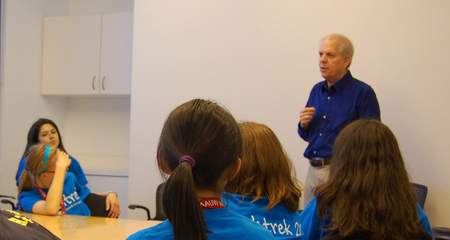March 25, 2015 at 2:02 pm
Published by Stanford Blood Center
The Stanford Blood Center (SBC) mission states “We provide hope for the future: teaching tomorrow’s leaders in transfusion medicine, researching to unlock mysteries inherent in blood, and connecting donors to patients every day.” Part of the work SBC does to...

February 18, 2015 at 9:39 am
Published by Stanford Blood Center
Although Stanford Blood Center (SBC) is best known for supplying blood products to hospitals, did you know it is also home to one of the top Human Leukocyte Antigen (HLA) Histocompatibility laboratories in the country? While our donor centers do...
September 10, 2012 at 1:55 pm
Published by Stanford Blood Center

By Dayna Myers, Marketing Communications Manager, Stanford Blood Center
Stanford Blood Center founder and Medical Director Ed Engleman, MD, took a break from the lab to share his inspiring story with a group of students from the Tech Trek science and math camp on July 16.
September 16, 2011 at 8:00 am
Published by Stanford Blood Center
By Lia Steakley, Social Media Producer, Stanford University School of Medicine

Woolly mammoths, which initially evolved in warm climates where African and Asian elephants now live, migrated to the cold regions of Eurasia in the Pleistocene glacial period. To survive living in the harsh permafrost, the Ice Age icons underwent distinct evolutionary changes such as growing long fur.
June 24, 2011 at 2:48 pm
Published by Stanford Blood Center
By Ed Engleman, MD, Founder and Medical Director, Stanford Blood Center

During the early 1980s we decided to apply new research technology to a clinical problem: the prevention of the transmission by transfusion of Acquired Immune Deficiency Syndrome (AIDS). The problem was highly charged with social, political, legal, ethical, and economic overtones complicating the technical and medical issues at hand. In a decision that engendered intense controversy, in 1983 Stanford Blood Center instituted the first blood testing program specifically intended to reduce the risk of transfusion transmission of the then uncharacterized, but presumed infectious cause of AIDS.
June 6, 2011 at 8:59 am
Published by Stanford Blood Center
By Ruthann Richter, Director of Media Relations at the Stanford School of Medicine.
One of the many controversies I covered was the decision by the Stanford Blood Center to be the first in the country to test for the virus in donated blood. The move was reviled in the blood banking industry, for it called into question the safety and reliability of the nation's blood supply. The blood center later would be vindicated, as every other bank would ultimately follow suit and routinely test for HIV. Center Director Ed Engleman, MD, says Stanford's early initiative saved some 30,000 lives.
April 19, 2011 at 10:50 am
Published by Stanford Blood Center
Tweet Guest post by Krista Conger, Science Writer for Communications & Public Affairs at Stanford School of Medicine. Click here to be taken to the original post on Scope, Stanford School of Medicine’s blog. Stanford researchers, led by pathologist Edgar...
March 2, 2011 at 3:55 pm
Published by Stanford Blood Center

By Erin Crager, Marketing Intern, Stanford Blood Center
The collateral damage associated with chemotherapy and radiation treatment may soon be a thing of the past. Medical students have traditionally been taught that the body's immune system generally doesn't turn on itself, even in the presence of a tumor. But Ed Engleman, MD and his research team at Stanford Blood Center have developed a method for training the body's immune system to do just that for prostate cancer. Their research over the past eighteen years has opened new doors for potentially curing other forms of cancer, as well.





